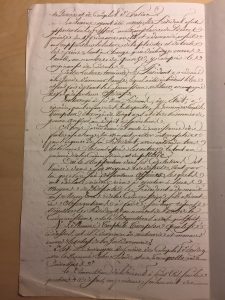
Service historique de la Défense, 2 J 447
During the Napoleonic wars, the French military commission met to decide the fates of English prisoners of war charged with many different offences. These documents are kept in the Service historique de la Défense in Vincennes. One of the offences that could be discussed in these proceedings was that of évasion. This is the term used most often to describe escape attempts, however, other terms did appear, and were used to indicate the status of the prisoner at the time of the escape attempt. The case describing Teophile Tomson is unusual in that multiple offences are listed.
These documents often list the name of the prisoner, their nationality, the offences under discussion and the outcome of the case in the upper left hand corner, which makes for easy reference. Each case is then given a number, which appears on all the pertaining documents. Tomson’s file also has a list of the members of the commission who appeared, their rank or position, and the name of the rapporteur recording the interrogation. Additionally, these documents often contain biographical and identifying information about the prisoner. These details can tell us a lot about how the French verified identity, organised and stored these records, and how they understood and categorised offences.
Tomson was, ‘accuse de mutinerie, complot de évasion et de menace enver les chefs de gendarmerie’, luckily, he is also listed as ‘acquittés’.[1] The proceedings are described carefully, and it is clear that these commissions did not operate as kangaroo courts. This is indicated by the careful attention paid to the process. For instance, it is recorded that the clerk, as appointed by the reporter, was chosen such that they would not have any conflict of interest, as required by law.[2] Likewise, when the judgement is considered, it is taken as a vote, and careful note is taken that the president of the commission calls on the lowest ranked, and the most junior in each rank, to render judgment before giving his own opinion. It is clear this procedure is included to ensure that no senior officer cannot influence the opinion of their juniors, nor that any junior officer will curry favour by deliberately matching their judgement to a superior’s. Though this process could in no way guarantee that all judgements would be uncompromised by politics and personal relationships, the appearance of regularity was important enough to record.
Additionally, Tomson is permitted an ‘unofficial defender’[3] and the services of an interpreter. It is by this means that he answers the questions put to him by the court. It is noted that he is also presented ‘libere et sans fers’, or free and without irons ie. chains or handcuffs. The witnesses are all presented and examined in the presence of the public and the accused, and the defender is given the opportunity to add anything that might aid in the defence. In this case, it seems the testimony provided by the witnesses was deemed satisfactory, as this invitation was declined.
Finally, the rationale for the acquittal is explained: for the charges of mutiny and menace, there is insufficient evidence of the attack.[4] Of the conspiracy to escape, it seems the head guard of the prison was to remain by the door through which they attempted to escape, but had not done so, and thus the charge was dismissed.[5] Tomson is therefore remanded into the custody of the chief of the prison depot.
The descriptions of the prisoners are also quite intriguing. Tomson is 20 years old, 173 centimeters (or five feet six inches) tall, with brown hair and eyebrows, a high forehead, grey eyes, a big nose, a large mouth, and with a round chin and full face.[6] These are the same details that would have been recorded on the passports required to move freely throughout France and which an escaping prisoner would have needed to forge, steal or otherwise bluff their way through checkpoints at the entry and exit of villages and towns.[7] These descriptions bring to mind the later attempts by Bertillon to identify criminals using anthropometry. Lacking the ‘scientific rigour’ brought in by Bertillon’s exacting method of physical measurement, these descriptions, and what precisely qualified as a large nose or a full face, would have been subjective. But, they are profoundly evocative to a 21st century reader, who can imagine how Tomson must have appeared that day in court.
Notes
[1]He is, ‘accused of mutiny, conspiracy to escape and menace against the leaders of the guards/police’, he is ‘acquitted’.
[2]‘Greffier nomme par le rapporteur; lesquels resont sarens on allier, ni entre eux ni du prevenu, au degree prohibe par les lois’
[3]Accompagne de son defenseur officieux
[4] ‘1e. de mutinerie et mancer envers les chefs de la Gendarmerie n’a soint trouve de preuves Evidentes de Cette accusation.’
[5] ‘2e. que par la seconde question il etait accuse du crime de complot d’evasion, cet article ne peut etre constant, prisque la chef de la prison dans laquelle ils etaient, etait rester par la porte pas laquelle ils sont sortis, sans trouver aucune resistence.’
[6] ‘age de vingt ans, taille d’un metre soixante treize centimetres, cheveux et-sourceils chatains, front haut, yeux gris, nez gros, bouche grande, menton rond, visage plein’
[7] For an example see F;7:3311 page 9










